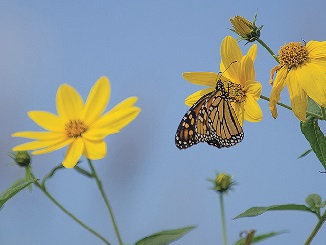Evolution can be quite handy, literally. The front paws, fins, feet or the equivalent for each of the Chesapeake creatures below are adapted to meet its needs. Can you match the animal to the description of its forelimb or equivalent? Answers are below.
BLACK BEAR
BROOK TROUT
GRAY TREE FROG
LITTLE BROWN BAT
PRAYING MANTIS
MONARCH BUTTERFLY
1. This creature’s paws have short, sharp claws that it uses like fingers to dig up underground insect nests to eat both the insects and the nest or rip open logs to get at the bees or their honey combs. Its short claws also make it easier for the creature to climb trees to grab fruit or nuts that are too high to be reached from the ground.
2. This creature gets its name from the angle that it holds its bent front legs together. Spikes on these legs are able to trap and hold onto its prey. It uses its front legs to snare its prey with reflexes so quickly that it is difficult to see with the naked eye.
3. This creature’s front (and back) feet have good taste. When it lands on a plant, it steps repeatedly on the leaves or fruit, which causes some of their juices to flow. Spines on the back of the legs “taste” these juices, letting the creature know if the plant is a food source. If it is a female looking for a place to lay her eggs, these receptors will also let her know if it is a good food source for her children once they hatch.
4. This creature’s “forelimbs” are a pair of pectoral fins, located on each side just behind the creature’s head. They are used to control the direction that the animal moves.
5. This creature has flexible toe tips with glands that secrete a sticky mucous. This liquid creates a suction between the toe pads and vertical surfaces. The toe’s flexibility also helps the creature get a better grip.
6. This creature’s long, thin forearm is 1.34 to 1.61 inches and strong enough to support the creature’s wing. It’s wrist is similar to other animals and is responsible for the moves that allow the animal to fly. Its thumb has a large claw that the animal uses to climb, grasp food or fight. The other “fingers” are part of the wing’s support.

Answers
1. Black bear; 2. Praying mantis; 3. Monarch butterfly; 4. Brook trout; 5. Gray tree frog; 6. Little brown bat
